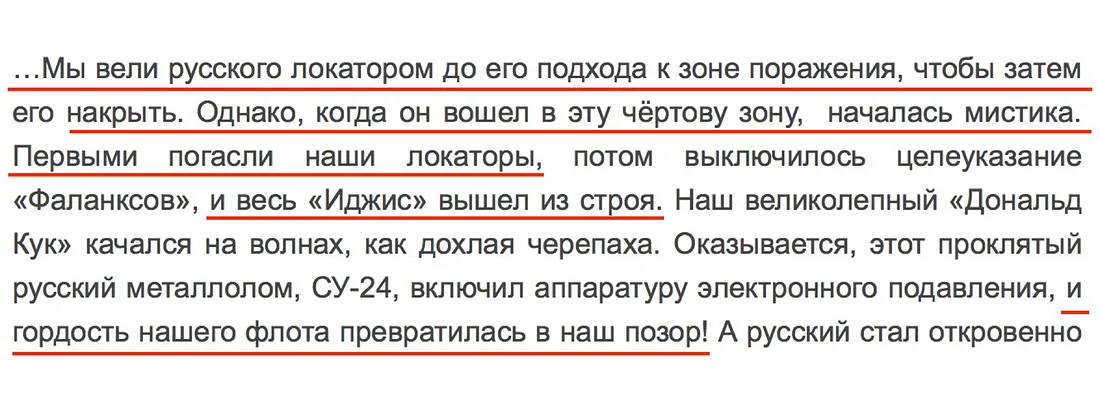Russia’s Fake “Electronic Bomb”
How a fake based on a parody spread to the Western mainstream
Russia’s Fake “Electronic Bomb”

BANNER: Source: Vesti. “The destroyer Donald Cook’s locator.”
On April 15, Russian state-controlled TV channel Rossiya-1’s “Vesti” news program broadcast a story about the latest developments in Russian electronic warfare. The report was timed to coincide with the Russian Electronic Warfare Specialists’ Day, one of many Soviet-era days dedicated to different branches of the military.
The broadcast, written up in English two days later, claimed that the latest Russian technology can disable any plane or ship by jamming its electronic systems. As proof, it alleged that a Russian Su-24 attack aircraft (NATO reporting name “Fencer”) had managed to knock out the USS Donald Cook, an Aegis-class missile defense frigate, in April 2014, by jamming its systems.
Within days the report had gone global, was picked up by mainstream outlets on both sides of the Atlantic, and reported with varying degrees of skepticism by UK tabloids such as the Sun and the Daily Express, and US outlets including Fox News.
The DFRLab can show that the story was a fake, based on a parody “social media post” from a sailor who never was. Moreover, the fake had been in existence since April 2014, including in the Russian state media, and had already been debunked.
What was the origin of the story, how can we demonstrate that it was false, and how did it spread so far?
The Vesti report
To showcase Russia’s capabilities in electronic warfare, the Vesti report focused on an incident on April 12, 2014, in which a Russian Su-24 made a dozen low-level passes close to the Cook in international waters in the Black Sea. According to Vesti, the Su-24 approached the Cook, “switched on the equipment, and powerful radio-electronic waves deactivated the whole ship’s systems.”
As the sole piece of evidence for this sensational claim, it quoted an alleged social media post from a crew member of the Cook, portrayed on the screen in Russian only, and retranslated into English for subtitles.
“This is how one of the crew members of the destroyer described these events in social networks.”
The following screenshots from the video give the Russian-language text of the alleged post, together with Vesti’s English translation, which is accurate, though not idiomatic:




Vesti claimed that the Su-24 was “equipped with the latest electronic warfare complex, Khibiny.” It added weight to its story by quoting US General Frank Gorenc, the former commander of the US Air Force in Europe, as saying that “Russian electronic weapons completely paralyze the functioning of American electronic equipment installed on missiles, aircraft and ships.”

Ending on a bombastic note, it claimed, “Experts are sure that in modern wars, electronic warfare is a key element. You don’t need to have expensive weapons to win, powerful radio-electronic jamming is enough.”
The facts
What are the facts of the story?
The Su-24 flypast was a genuine event, widely reported at the time. According to a Pentagon statement issued on April 14, 2014, one Su-24 made a dozen close passes over the Cook while its wingman stayed at a safe distance. Pentagon spokesman Colonel Steve Warren accused the Russian pilot of “provocative and unprofessional” behavior; Kremlin broadcaster RT reported the statement, based on reports from Reuters and the Associated Press, and added a Russian accusation that NATO was violating the Montreux Convention, which limits the amount of time foreign warships can spend in the Black Sea.
Neither side mentioned electronic warfare; instead, Warren underlined that the Cook was “never in danger” and was “more than capable of defending itself against two Su-24s.”
Following the incident, the Cook made a port visit in Constanta, Romania, during which she received a scheduled visit by Romanian President Traian Basescu and conducted exercises with the Romanian Navy and with American frigate the USS Taylor. She then departed the Black Sea on April 24, having entered it on April 10.
From parody to fake
The first question is whether Vesti’s story is true. Did the Su-24 manage to knock out an Aegis cruiser — one of the US Navy’s most modern weapon systems — by jamming it?
Warren’s statement would suggest not, but no official statement from any military should be taken at face value when it concerns the capabilities of their weapons systems, especially if they have failed spectacularly. It is therefore necessary to look at the evidence for Vesti’s claim.
The sole source for the claim that the Cook was disabled was the “social media post” from a crew member. Given the length (too long for a tweet), this is likely to have been on Facebook. It would presumably have been in English, as it ostensibly came from a US sailor. Although Vesti did not provide the original post, or any information on its source, the Russian version contained a number of translatable key words which make for a unique search (“Aegis,” “locator,” “mysticism” and “shame,” for example).
Entering these search terms in Facebook, a cluster of posts emerges, with the earliest dated to April 19, 2014.

These posts have a number of common features. They are couched as a letter to “My favorite Mary” (likely a direct translation of Russian любимая, meaning either “beloved” or “favorite”) from a Cook crew member called “Johnny.” They are written in what is obviously non-native English, probably machine translated (“We thrice cried ‘hip-hip hurrah’ and prepared to show the Russians that awaits them if they raise their hand for the second half of Ukraine”), and they link to a Russian post which first appeared on a website called fondsk.ru on April 17, 2014.

The fondsk.ru article provides the full text of the Johnny-Mary letter, in Russian. However, it is not presented as a news report or a transcript of an English-language original: it is presented as an opinion piece (“мнение”) by an author called Dmitriy Sedov, a regular contributor to the site.
Crucially for our investigation, Sedov’s opinion piece describes the moment in which the Su-24 allegedly shut down the Cook’s “Aegis” system in exactly the words which the Vesti report quoted three years later:

The match is too close for coincidence. Vesti’s alleged post copies the fondsk.ru text slavishly, and even inserts ellipses (…) at the appropriate points to show missing words.
Moreover, a separate Google search for the English terms “Mary,” “Aegis,” “fleet” and “shame” between April 12, 2014, the date of the incident, and April 17, 2014, the date of the fondsk.ru publication, returned just one hit: an unrelated post on realjewnews.com.

In other words, no extant English-language post matches Vesti’s alleged source, but a Russian-language opinion piece matches it perfectly.
The fondsk.ru article therefore appears to be the sole source for Vesti’s “news” report. Yet there is no indication that the article was meant to be taken as factual. It was labeled as an opinion piece and given the appropriate byline. The choice of the names “Johnny” and “Mary” has an element of caricature, the description of the crew’s behavior even more so:
“Mary, you can’t imagine how we were! We’ve never been so ashamed in our lives. Some of our boys bawled like babies, others beat their heads against the equipment that wasn’t working. The first officer drank down a whole bottle of whiskey in front of everyone and shouted, ‘Those freaking Russian Khibiny!’ and the captain was green with rage. In this condition, we were barely able to moor to the Romanian shore, and right after mooring, three dozen of our guys wrote their resignation letters. They couldn’t bear the thought that at the decisive moment our equipment could turn into crap, which they’d have to go to the bottom of the sea with.”
Every indication is that this was a parody designed to mock the US Navy. Adding to the impression, it was picked up two days later by a site called freepress.ru, where it was listed in the humor section, as shown by the use of the word “yumor” in the URL: https://freepublish.info/yumor/etot-proklyatyiy-russkiy-metallolom/.
Final confirmation that the story was a fake came from, of all places, the manufacturer of the Khibiny system itself. This is a company called KRET (Концерн Радиоэлектронные технологии, the Concern of Radio-Electronic Technology), part of state enterprise Rostech.
On February 26, 2015, KRET published an article extolling the virtues of Russian electronic warfare products, including Khibiny. The original has since been deleted, but it was archived in October 2016:

The entry on the Khibiny includes the following line:
“By the way, nowadays Khibiny is being installed on Su-30, Su-34 and Su-35, so the famous April attack in the Black sea on USS Donald Cook by Su-24 bomber jet allegedly using Khibiny complex is nothing but a newspaper hoax. The destroyer’s buzzing did take place. This EW system can completely neutralise the enemy radar, but Khibiny are not installed on Su.”
A separate KRET article, published in January 2016 and still extant (archive here), confirms this, referring to the alleged “blinding” of the Cook as “overgrown with numerous fantastical details” and an example of a “totally ridiculous story” about electronic warfare.
In short, the Vesti TV report of 2017, with its pomp and bombastic nationalism, based its most spectacular claim entirely on a misrepresentation of a Russian-language parody — despite the fact that the Khibiny manufacturer itself had already debunked the story. This is either a disastrous failure of due diligence, or deliberate deception.
Spreading the fake
If the intent was propaganda, it was effective. The Vesti report was picked up by the mainstream Western media, starting with two British tabloids, The Sun and The Daily Star. On April 19, both ran the sensational headline that Russia had an “electronic bomb” capable of knocking out the US Navy:

Within hours, the story was reported by British tabloid the Daily Express, and by Fox News.

The story then started to trend on social media and “alternative media” in both the US and the UK.

According to a BuzzSumo analysis, the Fox News version was shared over 27,000 times, mostly on Facebook; the original piece in the Sun was shared over 10,000 times, also mostly on Facebook.

Propagating the propaganda
However, not all viewed the Vesti report from the same perspective. The Sun, in particular, treated it with skepticism, headlining that the story was a “bizarre propaganda report” and pointing out in the text that the Russian media are “essentially controlled by the state.” It also reported that the US military denied that Gorenc had made the comment attributed to him.

Fox News, which picked up the Sun story, shortened its headline by omitting the reference to “propaganda,” most probably to save length, but included the comment on the Russian media being essentially state controlled.

The Daily Express was less wary, stating that the Russian electronic warfare systems “can destroy the American equipment installed on missiles, aircraft and ships,” although it showed a degree of caution by headlining that this was what Russia “claims.” It also quoted Gorenc, without mentioning the US rejection of the quote.
The “alternative” news sites, which are often marked by a much less critical approach to disinformation, largely amplified these posts without changing the overall tone. Before It’s News, for example, reproduced the full Sun article, including the “propaganda” headline, and added its own gloss, “propaganda or a technological reality?” War News Updates reproduced the Fox version, while ReportUK.org reproduced both the Daily Star and the Daily Express versions on consecutive days.
Even Investment Watch Blog (IWB), a known amplifier of fake news which has been termed “among the most untrustworthy sources in the media,” quoted the Fox News article with questions of its own:
Lets look at incident 1. Russia has claimed it can disable the entire US Navy in one fell swoop using powerful electronic signal jamming. A news report from the country claims the technology could render planes, ships, and missiles useless. Wow, if this is true, and I have no idea…what chance would we have against them if we went to war? I know there are some experts on IWB, who would actually know this.
Right now, I am questioning this news coming out of Russia. The report says, “Today, our Russian Electronic Warfare (REW) troops can detect and neutralize any target from a ship’s system and a radar, to a satellite.” The report claims a Russian war plane flew several times around American destroyer the USS Donald Cook in the Black Sea several years ago, disabling it systems and leaving it helpless. If this is true, whoa….bad news.
While showing doubt, the IWB article did not dismiss the Vesti piece outright:
This statement I do not understand: The report says, “You don’t need to have expensive weapons to win — powerful radio-electronic jamming is enough.” Are you telling me, this equipment and ability is not expensive? Does the US have it, too? If not, why not?
Overall, therefore, the Vesti report was met with a varying degree of skepticism, but achieved significant overall reach, being shared tens of thousands of times, and cross-posted on dozens of websites.
Second time lucky
This was not the first time the story had been pushed by the Kremlin media.
The first iteration of the fake emerged on April 21, 2014, when the German service of Kremlin outlet Sputnik claimed that a Russian SU-24 had “crippled” an American destroyer in the Black Sea (archive). The story ran the same day in English on Russian Radio’s India service; the original link is now inactive, but the story has been preserved by blog jhaines6, conspiracy blog Northerntruthseeker (which presented it as factual) and archive web.archive.org.

According to the English version of the article:
“Everything went normally, American radars calculated the speed of the approaching target. And suddenly all the screens went blank. ‘Aegis’ was not working any more, and the rockets could not get target information.”
It continued,
“After the incident, the foreign media reported that “Donald Cook” was rushed into a port in Romania. There all the 27 members of the crew filed a letter of resignation. It seems that all 27 people have written that they are not going to risk their lives. This is indirectly confirmed by the Pentagon statement according to which the action demoralized the crew of the American ship.”
The German version was an almost verbatim translation. The chief sources given were “Russian media and bloggers,” for the claim of the system being knocked out, and “the foreign media” for the Romanian visit.
The description of the course of events is strikingly similar to that of the “Johnny-Mary” letter: first the radar screens died, then the Aegis shut down and the air-defense missiles stopped working. Since the Sputnik reports do not name the sources for this part of the story, it is hard to tell whether the fake letter was their inspiration; the attribution to “Russian media and bloggers” certainly indicates that it is not based on credible sources, such as the US or Russian militaries.
The claim of mass resignations is easier to track, because the number is so specific. It can be traced to an article published in mid-April 2014 by online media outlet novorus.info, which calls itself the “central information agency” of Novorossiya, a term used by Russian-led separatists in eastern Ukraine.
The article was datelined April 18, but a Google search shows that it was referenced by Russian aggregator pikabu.ru as early as April 14, and debunked by Russian user “Maksym” late on April 15 (early on April 16, Moscow time).

The article claimed that 27 members of the Cook’s crew had resigned as a result of the flypast, quoting them as saying that they “do not intend to put their lives in danger.” Citing a Reuters report which quoted Warren’s Pentagon statement, it claimed that the Cook had been “urgently evacuated” to Romania because the flypast had “demoralized” the crew, who were undergoing “psychological treatment.”

In fact, as pointed out by fact-checking service StopFake, the Reuters report on Warren’s comment made no reference to an urgent evacuation, nor to demoralization, nor to psychological treatment. Far from being an emergency, the Cook’s visit to Constanta had been planned long enough in advance to arrange a presidential visit and a series of exercises.
The combination of false information and the misquoting of a named source makes it highly likely that this is another deliberate fake, presented as news, and designed to glorify Russia and denigrate the US Navy.
Nonetheless, on April 30, 2014, Russian state newspaper Rossiiskaya Gazeta ran a long and gloating article claiming that the Su-24 had targeted the Cook with the Khibiny system, knocking the entire Aegis system out of action, and that the ship had “hurried to a Romanian port to restore its nerves.” It also quoted a “range of media” as giving the “information” that 27 crew members had resigned.

“The Americans have got used to wiping out the badly-armed ranks of desert partisans with missiles while they sit in complete safety. And if it’s not like that, they don’t play,” it sneered, before reciting a long list of Russian electronic warfare assets.
The article wrongly attributed the claim that “the crew was demoralized” to the Pentagon briefing. The claim of 27 resignations was attributed to a “range of media,” without naming them or providing evidence. Again, the likelihood is that this article in Rossiiskaya Gazeta — the Russian Federation’s official newspaper of record — was another deliberate fake.
On this occasion, the fake had less reach. It was not until September 2014 that it began to spread significantly abroad. On September 13, anti-American site voltairenet.org translated the essence of the Rossiiskaya Gazeta article into Spanish, leading with the comment that “The great media of the Atlanticist press have not mentioned this incident, but the whole world’s military observers and experts haven’t stopped commenting.”

Translations into French, Portuguese, Arabic, German, Italian and Polish followed over the next ten days, with an English version in November:
“Since that incident, which the Atlanticist media have carefully covered up despite the widespread reactions sparked among defense industry experts, no US ship has ever approached Russian territorial waters again.”
The Voltaire Network story was picked up by a number of alternative and fake news sites in the United States. These included InfoWars (which claimed that the story had been “skipped over by the Pentagon-friendly corporate media”), Before Its News, Futurist Trendcast, Veterans Today, Gary North: The Tea Party Economist, LewRockwell.com, The Smirking Chimp, The Tap Blog, Above Top Secret and others.

However, on this occasion, it did not reach mainstream outlets, even tabloid ones. By December 2014 it had lost traction, and lay forgotten until Vesti revived it.
Conclusion
The fake “electronic bomb” story highlights important factors about the media both in Russia and in the West.
In the first place, it highlights once again the role of the Kremlin’s official media as tools of state propaganda. Every indication is that the national newspaper of record, and a national broadcaster, deliberately reported a total fabrication in order to glorify Russia (and its electronic warfare specialists) and mock the United States. Moreover, they did so repeatedly, long after the story had been debunked. Kremlin propaganda is a full-spectrum operation, and the state media are an integral part of it.
Secondly, it underlines the Kremlin’s need for domestic propaganda to shore up its support at home. Both in 2014 and in 2017, the initial circulation of the fake was in Russian; its international spread was secondary. This was a false story targeting Russian readers, with the apparent intention of reinforcing popular morale.
Thirdly, it suggests that the Kremlin may not be as confident in its high-tech military as it frequently boasts. The story of the blinding of the Cook was a fabrication, repeated even after it had been exposed by the manufacturer itself. Vesti’s decision to highlight it three years later certainly betrays carelessness on the part of the Kremlin propaganda machine; it may also hint at a lack of genuine stories to tell.
Finally, it underlines the importance of major Western outlets, especially tabloids, in the spread of fake news. The difference between the 2014 and 2017 fakes was that the Sun and the Daily Star picked up the latter version, and made it go viral. The Sun, in particular, treated it with appropriate caution, but nevertheless, the tabloid reporting was the main driver of the recycled fake’s penetration in the West.


